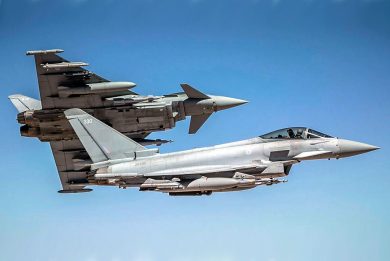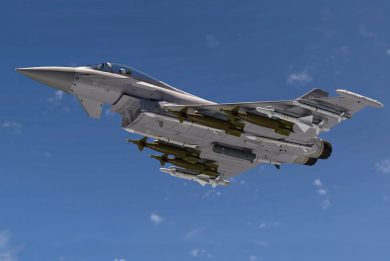
PAS 2019: Eurofighter awarded the Long-Term Evolution (LTE) study for Typhoon platform future
During this year edition of the Paris Air Show, the Eurofighter Jagdflugzeug GmbH and the EUROJET Turbo GmbH consortiums announced that the NATO Eurofighter & Tornado Management Agency (NETMA) have assigned them contracts worth € 53.7 million to support long-term evolution (LTE) of the Eurofighter Typhoon combat aircraft.
“These contracts represent a significant step in shaping the future of the Eurofighter Typhoon and will ensure it continues to be one of the most important assets in the future operating environment”, Herman Claesen, CEO of Eurofighter said during the consortium press conference. “We look forward working with our core nations to determine what this aircraft needs to be doing in the next couple of decades”, he added.
“We are delighted to begin a new chapter in the development of the Eurofighter Typhoon. The LTE study contracts will set out a clear roadmap for the future of the platform that will make it relevant and resilient for decades to come,” said Lt.Gen. Salvestroni, NETMA General Manager, aside the event.
Looking to the Typhoon programme, “we have delivered 558 aircraft and achieved over 550,000 flight hours. On the operational side, the UK Royal Air Force’s Centurion project upgrade is in service, providing the capabilities of the now-retired Panavia Tornado. Elements include the integration of MBDA’s Brimstone 2 and Storm Shadow air-to-surface weapons, and Meteor air-to-air missile. This capability is quite exceptional, and already proven in theater with good feedback”, said Eurofighter CEO.

The study contracts, which look at the Long-Term Evolution (LTE) of the aircraft, its avionics, the EJ200 engine and the weapon systems package, will span a total of 19 months for the aircraft and nine months for the engine elements.
The LTE study contracts will underpin the future of the Eurofighter Typhoon by identifying a suite of technology enhancements for the Weapons System infrastructure and the engine that will ensure the aircraft remains operationally effective and can continue to spearhead the partner nations’ air forces for the decades to come. “This will result in a clear costed roadmap into the future, to give our customers the capabilities they need for the next decades beyond the current enhancement programmes”, explained Raffael Klaschka, head of marketing for Eurofighter.
The high-technology areas being explored, according to the presentation provided during the press conference, include the mission system architecture, the Human Machine Interface (HMI), the defensive aids sub-system (DASS), the platform’s engine performance and the overall weapon system operational flexibility. Speaking about the mission system architecture, Klaschka said the LTE study will reinforce the already advanced avionics suite, by supporting the generation, transmission and utilization of ever-increasing amounts of digital data both on-board (via advanced multi-spectral sensors) and off-board (via “discreet” high performance tactical datalinks, including unmanned “loyal wingmen”), whilst remaining resilient to new and emerging threats, including cyber. “This will maintain Eurofighter’s Typhoon ability to operate in the highly contested and congested future operating environment”, he continued.

Illustrating the under-consideration HMI, the head of marketing for Eurofighter highlighted the introduction of a large area display as well as enhancement to the pilot’s helmet display and HMI philosophy refresh to enable more demanding missions in the future, whilst ensuring full interoperability with cooperating assets in the air and over land and sea.
“Operational flexibility will be assured by improved engine performance as well as new adaptive power and cooling techniques. The latter will facilitate the agile integration of advanced weapons, thereby enabling more flexible store configurations to be flown”, he explained. “Looking to the engine performances, the focus is on four key areas: thrust growth; range and persistence with increased parts life; survivability as well as control system enhancements”, he continued.

Introducing the potential future DASS requirements out to 2050, “enabling the Typhoon to cope faster, easier and more affordably with new requirements to counter threats as they arise in the future”, said Mark Hewer, vice-president of integrated mission solutions at Leonardo, “the threats to aircraft have never been so hostile, many of them being now agile, programmable and updatable”. Showing the present and future threats, including the SA-21 (S-400) and the SA-22 (Pantsir S1), “these high-end, long-range and short-range systems are becoming integrated, providing an even more lethal threat environment for present and future aerial platforms”, he said.
The LTE study will also therefore focus on enhancing the Praetorian Defensive Aids Sub System (DASS), which is supplied by the EuroDASS consortium, led by Leonardo but also involving Elettronica, Indra and Hensoldt. According to concurrent Elettronica’s released statement, “Within the framework of the LTE contract, a fundamental part is related to the study for the updating of the Praetorian DASS. Elettronica, together with other EuroDASS partners, will work to define a new solution based on cutting-edge technologies and advanced engineering architecture solutions.

The DASS activity boosts the ability to guarantee the platform safety in increasingly demanding and critical operational missions”. Answering EDR On-Line questions during an Elettronica press conference at the Paris Air Show 2019, Giovanni Zoccali, Elettronica’s VP Sales Europe & Consortia said “the LTE activity, and therefore also the DASS one, represents a great opportunity and can be the “technological bridge” for next evolution of the sixth-generation jet fighter. Elettronica will support such a strategic programme making available its expertise, consolidated over 70 years of world leadership in Electronic Warfare”. No further details have been provided during the Eurofighter press conference, but EDR On-Line understood the Preatorian DASS enhancing ‘feasibility study’ will see the consortium presenting in about 9 months a range of solutions with incremental modifications to the current DASS and airframe including a new architecture to cope with new requirements and new generation sensors, ECM and decoys, in addition to the integration between the AESA radar and DASS. The Eurofighter consortium and NETMA will then choose the solution and the EuroDASS consortium will work in the follow-on circa 9 months to define the technical requirements and suite solutions.
The LTE study will likely also look at physical stealth improvements, although this will probably be limited to special coatings rather than an airframe redesign. “Stealth is important, but counter-stealth technologies are developing,” says the Leonardo representative.
The study is separate and adds to the ongoing E-Scan radar effort, which aims to upgrade the Eurofighter’s current mechanically scanned radar with a new active electronically scanned array (AESA) system. The first AESA-equipped Typhoon will be delivered to the Kuwaiti Air Force, although it remains unclear when partner nations Germany, Italy, Spain and the UK will adopt counter-stealth technologies under development.
Photos and graphics courtesy Eurofighter



